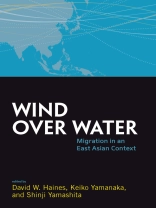Providing a comprehensive treatment of a full range of migrant destinies in East Asia by scholars from both Asia and North America, this volume captures the way migrants are changing the face of Asia, especially in cities, such as Beijing, Hong Kong, Hamamatsu, Osaka, Tokyo, and Singapore. It investigates how the crossing of geographical boundaries should also be recognized as a crossing of cultural and social categories that reveals the extraordinary variation in the migrants’ origins and trajectories. These migrants span the spectrum: from Korean bar hostesses in Osaka to African entrepreneurs in Hong Kong, from Vietnamese women seeking husbands across the Chinese border to Pakistani Muslim men marrying women in Japan, from short-term business travelers in China to long-term tourists from Japan who ultimately decide to retire overseas. Illuminating the ways in which an Asian-based analysis of migration can yield new data on global migration patterns, the contributors provide important new theoretical insights for a broader understanding of global migration, and innovative methodological approaches to the spatial and temporal complexity of human migration.
Table des matières
List of Tables
List of Figures
Preface
Acknowledgments
Introduction
David Haines, Shinji Yamashita, and J. S. Eades
Part I: Migrants, States, and Cities
Chapter 1. Human Trade in Colonial Vietnam
Nicolas Lainez
Chapter 2. Wind through the Woods: Ethnography of Interfaces between Migration and Institutions
Xiang Biao
Chapter 3. Migrant Social Networks: Ethnic Minorities in the Cities of China
Zhang Jijiao
Chapter 4. Migration and Diverse City: Singapore’s Changing Demography, Identity, and Landscape
Brenda S. A. Yeoh and Theodora Lam
Chapter 5. A Transnational Community and Its Impact on Local Power Relations in Urban China: The Case of Wangjing “Koreatown” in the Early 2000s
Kwang-Kyoon Yeo
Chapter 6. Immigration, Policies, and Civil Society in Hamamatsu, Central Japan
Keiko Yamanaka
Part II: Family, Gender, Lifestyle, and Culture
Chapter 7. Multiple Narratives on Migration in Vietnam and Their Methodological Implications
Hy V. Luong
Chapter 8. Cross-Border Marriages between Vietnamese Women and Chinese Men: The Integration of Otherness and the Impact of Popular Representations
Caroline Grillot
Chapter 9. Achieving and Restoring Masculinity through Homeland Return Visits
Hung Cam Thai
Chapter 10. Mothers on the Move: Transnational Child-Rearing by Japanese Women Married to Pakistani Migrants
Masako Kudo
Chapter 11. Here, There, and In-between: Lifestyle Migrants from Japan
Shinji Yamashita
Chapter 12. Moving and Touring in Time and Place: Korean National History Tourism to Northeast China
Okpyo Moon
Part III: Work, Ethnicity, and Nationality
Chapter 13. In the Shadows and at the Margins: Working in the Korean Clubs and Bars of Osaka’s Minami Area
Haeng-ja Sachiko Chung
Chapter 14. African Traders in Chungking Mansions, Hong Kong
Gordon Mathews
Chapter 15. Negotiating “Home” and “Away”: Singaporean Professional Migrants in China
Brenda S. A. Yeoh and Katie Willis
Chapter 16. “Guarded Globalization”: The Politics of Skill Recognition on Migrant Health Care Workers
Mika Toyota
Conclusion
Keiko Yamanaka, David W. Haines, J. S. Eades, Nelson Graburn, Jianxin Wang, and Bernard Wong
About the Contributors
Bibliography
Index
A propos de l’auteur
Shinji Yamashita is Professor of Cultural Anthropology at the University of Tokyo and former president of the Japanese Society of Cultural Anthropology, the world’s second largest national anthropology association. He is the author of Bali and Beyond: Explorations in the Anthropology of Tourism (2003).












